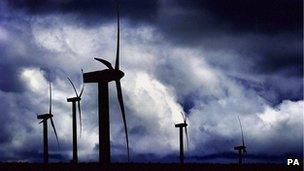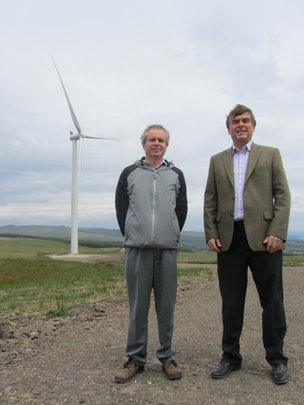Fight on for wind power subsidies
- Published

The issue of subsidies plays directly into the size of consumer bills
Wind power firms warn they may take the government to court if they get caught in a political row over subsidies.
After conducting technical studies, the energy department proposed a subsidy cut of 10% for power from onshore wind.
But the chancellor is under pressure from back-benchers to scrap subsidies, and is said to favour a 25% cut.
The industry body, Renewable UK, says it may take legal action if the government makes a decision that overrides its own technical evidence.
"It's really important this process is seen to be evidence-based and rational," said Gordon Edge of Renewable UK.
"The government took technical guidance on this issue. If at this point the government says we are going to do less for onshore wind than it proposed that will be seen as nakedly political."
Mr Edge told BBC News he believed that the industry might have a case for judicial review if the cut exceeded 10%. The government has previously lost in the courts over policies on solar and nuclear.
Visual impacts
It is politics that is delaying the announcement of subsidies for 2013-2017.
In Ayrshire, for instance, the wind energy body, Renewable UK, held an open briefing session last week about the benefits of community wind farms. The majority present appeared to favour windpower and the subsidies that underpin it, but a few were furious about the impact on the countryside.
One local, Aileen Jackson, told me she was disturbed by wind from a turbine near her home: "The subsidies need to be cut at least 50% to stop the wind farms taking over our landscape and making residents lives a misery."
That is the sort of anger which drove more than 100 backbench Tories to write to the chancellor demanding radical cuts in the subsidies to onshore wind that get paid through people's power bills.
The protest was led by Chris Heaton-Harris, MP for Daventry, who told BBC News: "I think subsidies should be drastically cut. The rumours of a 25% cut and zero subsidy by 2020 would be a good starting point."
Conservatives do not speak with one voice, though. The chair of the Commons Energy and Climate Change Committee (ECCC), Tim Yeo, warned that cutting subsidies too fast would actually increase bills.
"We know there's a great political controversy surrounding onshore wind, particularly within the Conservative Party. I think some people don't appreciate that amongst the low carbon renewables, onshore wind offers better value than many alternatives. Reducing onshore wind would mean putting up bills for consumers," he said.
Steady gains
All parts of government want to see renewables stand on their own feet without subsidy - the question is how fast it can be achieved.
The Department of Energy and Climate Change (DECC) arrived at its 10% cut proposal after commissioning reports from Poyry and Arup, and hearing evidence from academics and the wind industry.
Experts I have consulted broadly agree that the subsidy can be cut - but not by as much as 25%. So, how much leeway does the government have? How far can wind farms improve, and how much will costs come down?
Colin Morgan from the leading technical consultancy Garrad Hassan told BBC News that the modern wind turbine was a better neighbour than its predecessor - quieter and turning slower.
A modern wind farm used 2,000-3,000kW turbines compared with the 300kW turbines of 1990. Some old wind farms have recently been re-powered to achieve dramatically improved output from higher hub heights, more efficient structural design, improved layout and other turbine refinements.
"There's still steady progress being made on the technical efficiency of turbines, through incremental developments as well some new technologies coming into play - like converter technology and permanent magnet generators.
"We are probably talking about future potential for a few percent of improvement in annual energy output. To improve that dramatically would require the breaking of some laws of physics."
He said research into reducing wake losses (caused by wind turbines operating in the wake of others) might also yield significant improvements. But he warned that a cut of 25% in subsidy would risk "bringing the industry to a grinding halt".
'Local power'
Prof David Infield from Strathclyde University told BBC News that the efficiency of wind turbines had almost doubled since early models but that technical efficiency was reaching a plateau. He said the cost of manufacturing wind farms could be expected to fall slowly as the industry expanded. But he said a 10% subsidy cut was about right for now.
"Developers are being squeezed by rising materials costs and capital costs. I don't believe that profits for developers are excessive - but investors' profits are often excessive. If the government continues to mess around with subsidy levels that will increase uncertainty and give another excuse for developers to put up the cost of capital."

New turbine designs are delivering greater efficiency
Energy consultant Nigel Cornwall said the issue of subsidies was complicated, as developers received the same subsidy for a very windy site as for a less windy site. He added: "That means the single band of support is very generous for some developers but not enough for others.
"All this talk of cutting subsidies at the last minute is political rubbish. If the government cuts too much, a lot of less well-positioned sites with lower wind speed but close to population centres won't get developed. That makes no sense. There should be a premium on local power - we shouldn't be driving all the wind power to the edges of Britain where there are poor transmission lines and no-one lives."
Rod Wood, managing director of Community Wind, which is using new efficient Siemens gearless turbines at its site in Daly, Ayrshire, told BBC News: "We can tolerate a cut of 10% in subsidy. But 25% - forget it. It would kill the industry stone dead."
Policy targets
The subsidies debate is part of a broader battle over energy policy between government and backbenchers and between DECC and the treasury. The UK is struggling to meet two legally binding environmental energy targets: to cut CO2 80% by 2050, and to get 15% of energy from renewables by 2020.
Both will require investment estimated at £8bn a year by 2020. Current investment is funded by a levy on energy bills, but the levy has been capped by the chancellor to 2015 and the cap to 2020 has not been fixed, adding to the confusion amongst investors over future policy.
MPs on the ECCC wanted to ask treasury ministers if the cap would over-ride the energy and CO2 targets, but ministers refused to give evidence, saying that it would be improper to comment on another department's affairs.
Tim Yeo said: "This is disingenuous. We are supposed to be conducting pre-legislative scrutiny of the bill, but we can't do that if the treasury's influence can't be scrutinised."
The Energy Secretary Ed Davey told the MPs that laws on energy and climate would be met.
Next week experts at the International Energy Agency will urge governments to keep up subsidies to renewables to keep production rising and the price falling in the long term.
- Published26 June 2012
- Published22 May 2012
- Published24 May 2012